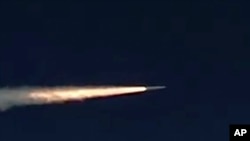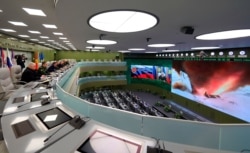U.S. senators are concerned Russia and China may outpace Washington in developing hypersonic weapons.
In a Senate Armed Services Committee hearing Thursday with top defense officials, lawmakers expressed concern about the weapons that fly at five times the speed of sound, or Mach 5.
Democratic Senator Richard Blumenthal of Connecticut called the hypersonic weapons “a game-changer.” Independent Senator Angus King of Maine called them “a nightmare weapon for aircraft carriers.”
“It sounds to me as if hypersonic weapons and other future weapons have been more advanced by other countries such as China, even Russia coming back into the scene in a real aggressive way … are we going to deter them from moving forward?” asked Democratic Senator Joe Manchin of West Virginia.
Maintaining strategic deterrence
Testifying before the committee, Admiral Charles Richard, commander of U.S. Strategic Command, admitted to the ongoing competition. But he sought to reassure the senators that the U.S. has the necessary deterrence capabilities.
“I am confident that this nation has the ability to produce the capabilities we have to have,” he said. “And for deterrence, again, the basic equation hasn’t changed. Can I deny you your aim, or can I impose a cost on you that is greater than what you see? I can do that if necessary.”
Richard added that the U.S. maintains conventional superiority over Russia and China while maintaining strategic deterrence.
Experts say, however, that hypersonic weapon systems could change the existing balance of conventional military power between the U.S. and its major competitors.
According to the Congressional Research Service, the research arm of the Congress, both China and Russia have conducted numerous successful tests of hypersonic glide vehicles and both are expected to field an operational capability as early as 2020.
There are two types of hypersonic weapons: cruise missiles and glide vehicles. Both are difficult to track and intercept because they can maneuver in midflight.
Boosting budget for hypersonic weapons
This is why continued investment is critical in the hypersonic weapons tracking layer in space, according to General Terrence O’Shaughnessy, commander of the Northern Command and North American Aerospace Defense Command, who testified at the same hearing.
“We need to continue to invest in that space sensing layer, because as we go from a ballistic missile to a hypersonic glide vehicle, it really changes the problem of maintaining custody of that weapons system throughout its entire flight,” said O’Shaughnessy.
In the 2021 budget released Monday, the Trump administration proposed $3.2 billion for hypersonic weapons, a 23% increase from last year.
“FY2020 represents a pivotal year for hypersonic weapon development and fielding as the department begins aggressively flight-testing capabilities across multiple domains,” Richard said in written testimony. The Trump administration has yet to specify when it will field American hypersonic weapons.
New START Treaty
Senators also asked top military leaders about what to expect after the New START Treaty expires in February 2021.
While noting that extending the treaty is ultimately a political decision, Richard pointed to some of the shortcomings of the agreement.
“It does not address a very large class of weapons that the Russians have a significant advantage in, it doesn’t constrain novel systems, and it is a bilateral treaty,” he said.
He expressed a higher level of distrust in China’s intentions in nuclear weapon development.
Richard said he could “drive a truck through China’s no-first-use policy,” adding, “They’re very opaque about what their intentions are. They’re very different from the Russians.”
The Trump administration is seeking to forge a trilateral arms agreement with Russia and China, although China has so far refused to take part.










